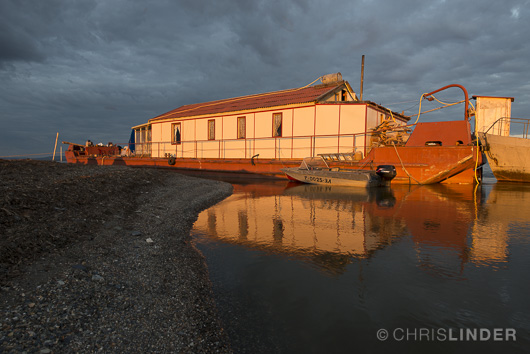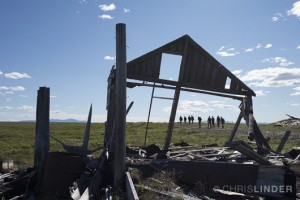The barge is the central hub of life. It hugs the shore of the Kolyma River, which at this latitude is about five kilometers across. The metal hull is about 30 meters long with a 10 meter flat deck in the bow where two tents sit. They are tied down by an ancient bison femur, a mammoth scapula and other bones we found on our travels. REI’s strategically placed logos usually make me feel like I am in a commercial, but on the deck of this rusty barge they seem wildly out of place. Surrounding the tents is a slew of science and boating equipment. Behind the deck sits the living quarters, which look like a small narrow house plucked from a neighborhood and affixed to the deck. Inside there is a wide open dining hall that funnels into a narrow hallway. Doors on either side open to bedrooms with our bunks.

The Barge at its mooring on the tundra.
So far I have noticed two weather patterns, which are loosely correlated: cloudy and mosquitoy. Cloudy days are particularly cold and sunny days extremely hot. Without day and night, the clouds seem to be the main temperature control. Mosquitoes may not be weather, but we talk about their presence like weather phenomena. People wake up and ask early risers how mosquitoy it is and whether they should wear a bug shirt, like asking about rain and whether to wear a rain jacket. Over time I have started to realize that every day is mosquitoy and asking how to prepare is only making space for false hope.
Yesterday we did a tundra walkabout to see the landscape we were going to study. The barge is moored on a rocky beach that extends east for only a few hundred meters, transitioning into an enormous marshy floodplain. A tributary of the Kolyma runs next to the floodwaters and snakes up into hazy peaks. Cliffs of fine shale loom over the water, with snow still pooled at their base. To the west, the Kolyma is wide enough to appear like an inland sea. The distant shore is faintly visible.
Remains of a Soviet road climb from the beach to a shelf above the cliffs. After walking the road, the view yawns to gently rolling hills of shrubs and grasses with wide sky above. A faded airstrip stabs awkwardly straight inland. On either side, the rusted skeletons of a military outpost wait for a war that never came. A smashed tea kettle, warped saw blade, carburetor, pile of burned boots, stacks of uniform barrels and other remains are strewn about on both sides of the road.
Polaris students hike the “road”.
Even though it’s morning, the clock reads 9:30 am. Lower latitude brains think morning should include particular features like dawn, dew and chirping birds, but here the morning is just a continuation of everlasting day. I keep a close eye on my watch, otherwise I would never sleep. Already I have found insomniac tendencies coming out. Last night I went to bed at 2:00 am and awoke at 6:30 am — nothing outside changed from when my eyes closed, to when they opened.
This morning we are bumbling around in chaos preparing for the first day of field work for our own projects. After breakfast is the busiest time of the day. The narrow hallway is treacherous with abruptly swinging doors. Students chase professors, pestering them with questions about the feasibility of this method or the merit of that concept. Despite the student’s years of education in science, there is a huge bottleneck of scientific and logistical information that can only come from mining our trip leaders. Many of us are just looking for the equipment we need, so we pilfer the piles of equipment only to be reprimanded for breaking the arcane organizational system. With only two weeks remaining in the trip, most of us move at a frenetic pace — the real work has begun.





Comments(4)-
-
-
-
Larri Spengler says
July 13, 2014 at 5:11 pmThank you, Julian, for giving us a sense of what the set up and atmosphere is like there, in a most foreign place. What an amazing experience for all of you – and not only scientifically!
Teri Theberge says
July 14, 2014 at 9:12 pmGreat to hear from you! The descriptions you give are really wonderful. I can just imagine…
Kathy Patrick says
July 17, 2014 at 9:37 pmI had not received such a realistic picture of the barge and conditions in all the time I have been reading about the Polaris Project until I read your blog. Keep up the great work, but close your eyes sometimes. This experience will be over far too quickly.
Roger Theberge says
July 20, 2014 at 10:51 pmExcellent writing Julian! Get some sleep